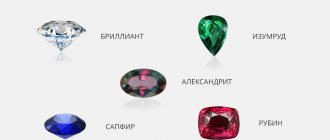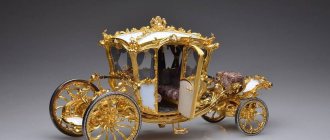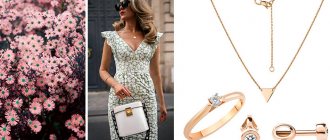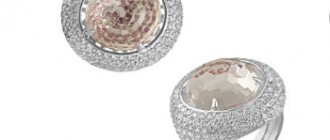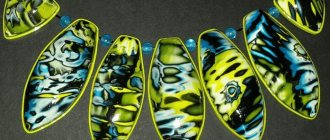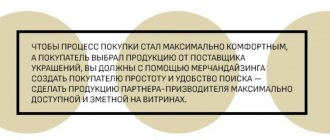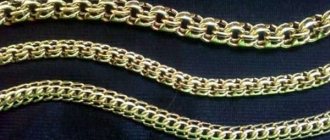Jewelry merchandising has its own characteristics, because it is designed to ensure sales of luxury goods. Based on the awareness of this fact, merchandisers are able to significantly increase sales volumes.
When considering the jewelry market, two segments can be distinguished. The first is focused on the sale of exclusive, expensive products, and the second is designed for more affordable, but more massive sales to the average buyer. Depending on the specialization, the location of the jewelry sales point, the interior design of the store, the features of the product range and the rules for displaying various trade groups on display windows are determined.
Today in jewelry stores you can purchase products for various purposes, this is not only jewelry, but also accessories for both sexes, interior decorations, tableware items, souvenirs, religious items, and various types of weapons.
The largest mass of products on sale are jewelry intended for personal use. They, in turn, are divided into several groups depending on the area of wear: for the head (earrings, tiaras), for the hands (rings, bracelets), for the neck (chains, pendants, necklaces). A separate group of jewelry should include sets that combine several items into a single whole.
Accessories in stores today are represented by an impressive variety of products, including cufflinks, jewelry boxes, belt buckles, tie clips, hat pins, mirrors, powder compacts, and so on.
Table setting items combine not only all types of cutlery, but also fruit vases, glass holders, place settings, glasses for alcoholic drinks, napkin holders and much more. Among the materials used in their manufacture are silver, cupronickel, stainless steel, crystal, porcelain, and natural animal horns.
Among jewelry products, not the least place belongs to a variety of artistic products made from stone, leather and other natural materials. First of all, these are a variety of decorative items, interior items, for example, wall decorations, sculptural compositions, and so on.
For jewelry writing instruments, silver and cupronickel are most often used in the manufacture. They are used to make inkwells, glasses for office use, writing instruments, and so on.
A separate category of jewelry is represented by accessories for watches, wrist and pocket watches, forming two separate groups of goods.
Another category of jewelry products is represented by smoking products. These are cigarette cases, lighters, cigarette holders, various cases for storing accessories, ashtrays and much more.
An equally extensive product range is provided for souvenir products. It includes commemorative badges and medals, a variety of keychains, souvenir sculptures and handicrafts, samovars and other items of various sizes.
Products of religious worship are crosses, products for organizing religious worship, bindings for literature, panagias, and so on.
For the product category of weapons, both bladed and firearms, various types of decoration of handles and other surfaces using precious stones and metals, the use of handles made of animal horns, decorative carvings on the surface, and so on are used.
For jewelry merchandising, as in the sale of branded clothing, the main attention is paid to visual effects. Among the main points that influence sales volume are the selection of the optimal location of the point of sale in accordance with the target audience, the design of display windows with decorations, the interior of the premises itself, the choice of retail and lighting equipment, the use of information and advertising materials.
In most cases, jewelry stores are located on central streets, in the most prestigious areas, in places with high traffic.
In the process of organizing merchandising, it is necessary, first of all, to start from the target orientation of the store - the sale of exclusive jewelry or the sale of jewelry for a wide range of customers.
Basic rules for displaying goods in merchandising
Stores belonging to the category of “mass” and “medium” sales in most cases use “tablet display”, in which medium-sized display cases are installed along the perimeter of the sales floor. Each tablet is designed to contain jewelry from only one product group, while several tablets with identical jewelry are placed on a common counter. If you have a large assortment of decorations and you need to use several counters, they should be installed next to each other.
To make fuller use of the space available at the showcase, it is recommended to use a multi-level system for displaying lots.
Jewelry merchandising is characterized by concern for the convenience of the client, therefore display cases with jewelry are installed at intervals that ensure freedom of movement for clients. It is recommended to display goods in stores sequentially, providing the opportunity to get acquainted with the entire assortment as the buyer moves between display cases.
Individualization of display cases can be achieved through compositional display using items from various objects. At the same time, with an increase in the cost of products, the share of products presented specifically as part of compositions should be greater.
Compositional display is used especially effectively when selling sets that were originally created for shared use. In the center of such a composition is an object that has maximum dimensions and is the first thing that catches the buyer’s eye. From there, connections are further built with other objects from the composition.
Design contribution to interior furnishings
Designer services when creating a jewelry store environment include the following:
- marketing analysis and accounting (calculation of purchase volumes, study of store location and customer flow statistics, analysis of the presented assortment, study of the size of the sales area and its potential),
- creating a concept for decorating the interior of a jewelry store (in color, with a precise layout of individual items, justifying the convenience of this particular location, etc.),
- control over the production of display cases for jewelry (in order to develop a unique or at least typical design project that suits you, the designer must have practical skills in working with natural materials - precious wood, leather, stone, fabrics, as well as with special computer programs).
Recommendations for stores
Jewelry merchandising provides a number of rules for the design of points of sale:
- It is advisable to use decorative elements designed in the general style of the interior of the room.
- Brightness of lighting, both external and internal to a retail space, capable of attracting additional attention.
- Good visibility of the entire product range, placed at the optimal height for a person (elbow level of a standing person).
- The presence in stores of clear, but at the same time compact price tags that do not interfere with the buyer’s consideration of the product.
The system for separating goods involves the use of separate display cases for products with and without stones, with division according to the metal used, specific stones (diamonds, garnets, rubies). It is recommended to place jewelry-related products in separate display cases.
For a more effective display of jewelry, it is recommended to use substrates of a contrasting color to help visually highlight the lot on the surface. A large number of mirrors in stores not only improves lighting, but also allows the client to conveniently try on the selected product.
Interior design of display windows in a jewelry store/salon
For the interior decoration of display cases and counters, information podiums are used - special display elements on which jewelry is presented.
Jewelry merchandising experts recommend choosing runways in light colors or signature colors. And for inexpensive products and jewelry - podiums made of transparent plexiglass.
Experts also highlight the following important features of the design of jewelry display cases:
- Stylish unity of design: classic decorations do not need unnecessary pathos; restrained and strict window dressing is suitable for them; designer jewelry requires additional space and an individual approach: it is better not to overload compositions with them, smoother transitions and lines will additionally emphasize their uniqueness and grace;
- A piece of jewelry should “sparkle” in the display case, which is facilitated by the use of a velvet base, proper selection of lighting, as well as natural elements of natural origin for decoration. The price of decorating a jewelry store window takes into account the use of all of the above components by the interior designer/invited merchandiser;
- A “broken” line of display cases will help you increase the display of furniture elements, physically increasing the area for displaying the product.
Features of equipment for jewelry stores
When selling jewelry, the closest attention must be paid to the selection of retail equipment. It is recommended to use products in the same style and color scheme, corresponding to the general line of the point of sale.
The equipment requires both aesthetic appeal and a high level of functionality, and the seller must be able to easily handle the jewelry while displaying it to customers. At the same time, it is necessary to ensure security measures in such stores to protect against theft of high-value goods.
Increased requirements for the lighting system. It should provide a high level of brightness. In this case, even light is required, preferably in the white spectrum. For store windows where the most expensive jewelry is displayed, additional lighting is advisable to highlight the products from the total volume and attract the attention of visitors.
Spot lighting directly next to the lot allows you to see it in more detail, to see all the nuances of the shapes and solutions used by the jewelers.
Development of a showcase project
Showcases for selling jewelry can be considered successful if they:
- obey a single concept and give the impression of integrity of the plan,
- their color scheme is harmonious and does not hurt the eyes,
- have several levels, include decorative elements and durable frames,
- have carefully thought-out lighting that helps illuminate the products both during the day, in good sunny weather, and in cloudy times and at dusk.
In terms of composition, jewelry display cases have 3 main types:
- in 1 row - this is how all products are laid out - in a straight line,
- stepped, which can be straight or spiral. Products are located at different levels,
- a composition of various products that are arranged from left to right in accordance with increasing size.
Products on jewelry displays should not interfere with each other. In order for the buyer to be able to freely examine each product and pay due attention to any item that interests him, there must be enough empty space for them to move freely.
When designing a display case for selling jewelry, special attention should be paid to lighting. Halogen or LED, it can be strip or spot. The latter creates a better effect than diffused light. It is important to avoid shadows falling on the product, as well as overly bright light, which is inconvenient for some jewelry, in particular with colored stones. The best light is one that hits at a 45° angle, so the source should be in front and above, directly on the buyer's side. You should pay attention to the warmth of the light: for silver and gold plated the ideal option is cold light, and for jewelry - warm light. Good quality lighting, and an original one, made to order, is not a cheap pleasure. Accordingly, the more expensive the lighting, the more expensive the showcase.
https://westcom.ru/torgovoe_oborudovanie_dlya_yuvelirnykh_magazinov/
Visual Merchandising Tips: Displays and Windows
A store window is a promising source of attracting customers. Even if there is only one in your establishment, then it can be properly decorated with printed products of a certain style and content, which will help increase profits. Options for window dressing are very diverse; they may depend on the time of year, current holidays, social conditions in society, popular films and much more. To use the windows of an establishment correctly, you don’t need to evaluate them solely as a source of light in the room - they can very well become a tool for promoting your own brand. If you present your goods and services in a showcase in a visual style, you can attract consumers and force them to show the necessary activity in your direction.
There are a lot of rules for designing storefronts and windows so that they are not only beautiful, but also functional in terms of marketing.
To achieve results from merchandising, you will need:
- • Evaluate the visual content of your products. Do your products look beautiful, do they have attractive packaging, can they be of interest to people passing by? If this is so, then half the job is done; if not, we urgently need to work on the packaging design;
- • Determine the target audience. There are enough methods to solve this problem; the essence of the task is to understand whether representatives of your target audience will generally walk under store windows, or whether they hang out somewhere else;
- • Select a location. If the store is located in courtyards, then the chances of attracting a large number of customers are minimal. It is also worth considering that you can attract not only pedestrians, but also drivers and public transport passengers passing by.
Visual merchandising depends significantly on these factors.
Three options for attracting clients
To understand how to beautifully and correctly design a store window, you need to consider the three most effective strategies:
- Create a complete scene. Design the product beautifully, show people some of its “history”, features that may be interesting to a person passing by, will hook him. For example, if you sell food products, you can place them on a table for exhibition purposes or as a picnic in nature. This will bring the picture to life and provoke certain associations and desires among consumers;
- Advertise your product or service. Sometimes you don’t need to come up with anything new - it’s enough to focus on advertising your existing key product and demonstrating its most worthy qualities. Show the product, packaging in a favorable light, present its advantages, advantages, answer in a visually expressed form why people need it;
- Actively exploit the festive atmosphere and seasons. Seasonality is very important for many products, because even fruits in winter are in great demand - people need additional vitamins. Spring, New Year's window decoration, Valentine's Day styling or something like that will definitely attract more people and revenue.
For example, using spring window dressing after the winter cold has subsided can help people decide to buy things that are more likely to become relevant: windbreakers, sneakers, light spring clothes, etc.
How does a jewelry store influence the buyer through feelings?
- Sunlight. Some studies confirm that natural light in a jewelry store has such a positive effect on visitors that with an increase in glass area, sales increase by 10%!
- Color of decoration, display cases, information signs. The right color scheme increases customer activity. Red is clearly associated with a discount, orange evokes a feeling of well-being, gold and silver emphasize the elitism of the product.
- Background effect. Jewelry with stones of rich colors is placed on a light background. Jewelry with diamonds looks luxurious on black velvet, provided that it is properly illuminated.
- Emotional advertising posters. A couple in love, happy girlfriends, a mother with a child - all these images cause a surge of endorphins. “Happiness hormones” reduce critical perception and encourage you to please yourself by buying gold jewelry.
- Aromamarketing. Most often, jewelry stores use citrus scents, which stimulate purchasing decisions, and the scent of roses, which makes buyers more accommodating.
- Shopping music. A salon that plays instrumental melodies without words sells more. Music puts a person into a comfortable state in which he wants to stay as long as possible and therefore spends more time in the store. At the same time, the buyer is not distracted by the speech going on in the background and is completely immersed in the process of choosing jewelry.
Manipulations have no effect on those who know how to read them. An attentive buyer is guided only by his own, and not by imposed ideas about what he really needs.


